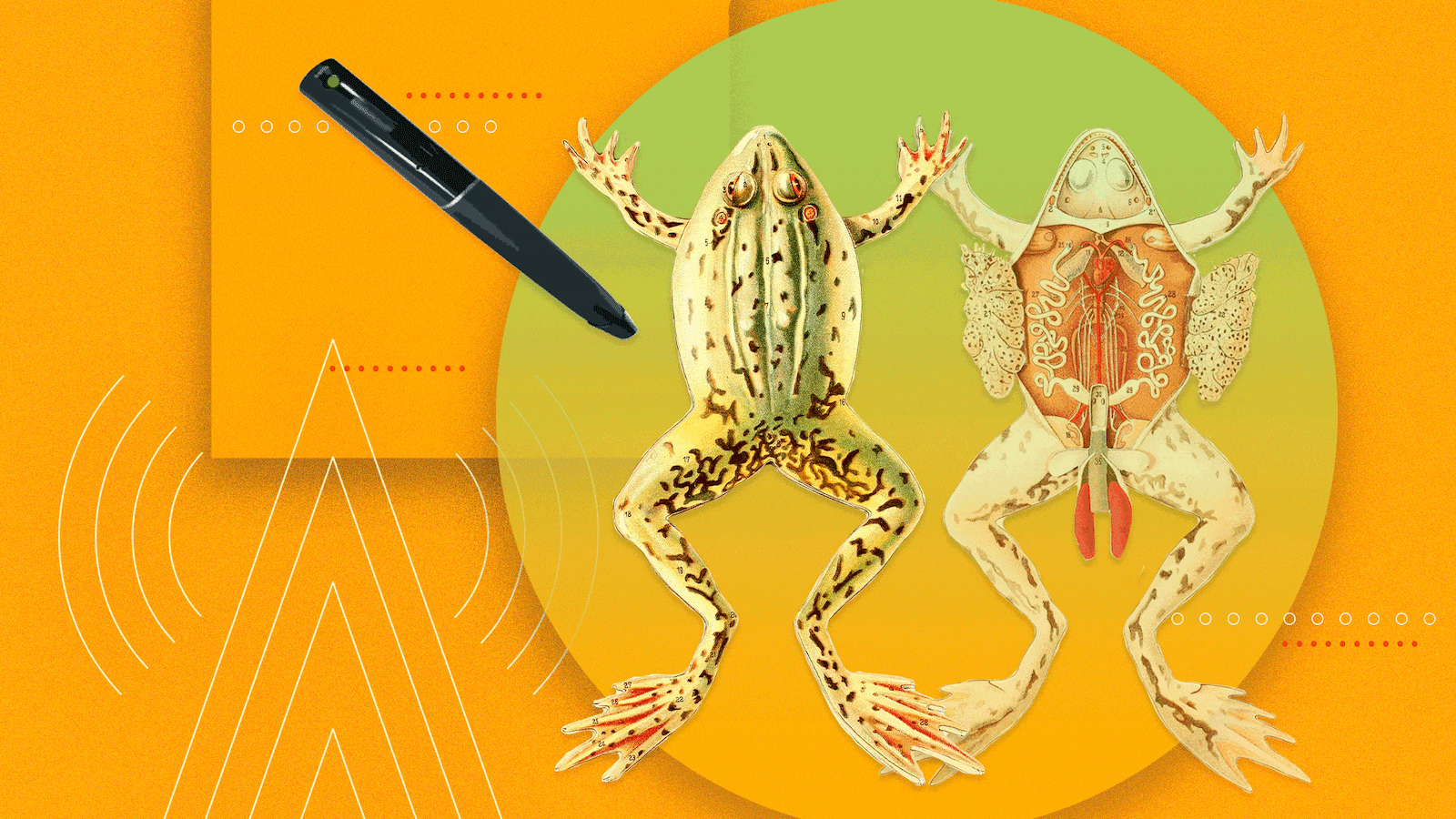In a fifth-grade classroom in upstate New York, a girl sits at a desk wearing a pair of oversized tinted glasses, gingerly holding a pen in mid-air. The pen, connected to her computer by a thin, black cord, is controlling the three-dimensional image of a lifelike, green frog that appears to pop out of the computer's screen. With the pen, she manipulates the image, twirls it around in the air, and, with a flick, removes the top layer of the frog's skin. With another flick, the frog's belly is opened to reveal its internal organs—the puffy pink lungs, the blistery red heart, the swirl of its intestinal track.
A decade ago, animal dissection was only possible by using a once-living specimen, often dunked in a jar of formaldehyde and splayed open on a tray to be shared between other biology students. Now, with the rise of virtual reality and high-speed internet, students—even young ones—can experience animal dissection in real time, in the classroom and outside of it.
“What we know through research is that experiential learning is, in general, better than learning through a book or a video,” says Mike Harper, Executive Vice President and CMO of zSpace, an augmented reality platform that's becoming steadily more available in school districts around the US and abroad. “We learn through experiments the fastest and the best, which is why we use technologies to deploy augmented reality, in order to make that happen.”
Space is only one of several virtual reality (VR) and augmented reality (AR) systems starting to crop up in classrooms, covering subjects like animal dissection and anatomy, but also others like geography and history. Virtual reality systems, such as Google Expeditions, allow students to walk through a virtual world, while augmented reality systems add digital elements to a live view (or, like zSpace, allow students to manipulate and interact with 3D objects). While some systems use apps to download content for use offline, many VR and AR systems require high-speed internet capabilities for a seamless streaming experience.

According to Harper, the benefits of using augmented reality systems for education are numerous—and for biology, even more so. “Frogs, for instance, aren't expensive,” he says. “But when you're dealing with cow hearts and other specimens there's a cost savings.” Additionally, with augmented reality, each student can dissect an entire animal multiple times, without worrying about making an error or having to share learning time with another student. And while it might seem like using a real specimen would give students a more true-to-life look at the anatomy of a once-living animal, a dead specimen can actually impede learning in some cases. “When you take an animal and kill it and preserve it for dissection, things are going to change because the circular system isn't pumping,” Harper says. “The veins tend to collapse and it doesn't look like a living animal would on the inside.”

But the benefits aren't limited to just biology: Research has shown that any kind of experiential learning—meaning learning through doing—improves long-term memory acquisition and fosters engagement along with a deeper retention of the materials studied. “When kids can touch what they're learning and engage as though it's right in front of them, engagement goes up and they're more inspired to be curious and dive into things,” Harper says.
For now, zSpace is application-based. Users can access the frog dissection model, as well as other 3D programs like simulated archeological digs or interactive geometry, from pre-installed programs on the computer. But Harper says the company is starting to expand into web-based content as well.
“In our browser products, there'd be a picture coming from the web browser like you see now in the apps, and students would be able to engage in learning right on the browser,” he says. With the frog, students would be able to manipulate and dissect it as it springs to life on the webpage, provided the internet connection is sophisticated enough to support the interface.
While app-based AR and VR systems promise experiential learning, online AR and VR systems have the potential to make education truly democratic. Currently, though AR and VR programs are gaining steam, they are available mostly to school districts or universities with large funding, since these programs often require headsets or the use of handheld devices. Web-based programs like the one offered by zSpace, which is slated to appear in select classrooms next spring, would allow any student with a reliable internet connection access to these systems—something that's on the horizon with the advent of 5G technology.
In select biology classrooms around the country, students are manipulating frogs in mid-air, exploring their organs and bodily systems with a flick of the wrist and committing them to memory. As AR and VR continue to grow—and as 5G technology is implemented—what might have once seemed like science fiction will soon be available to students everywhere.





